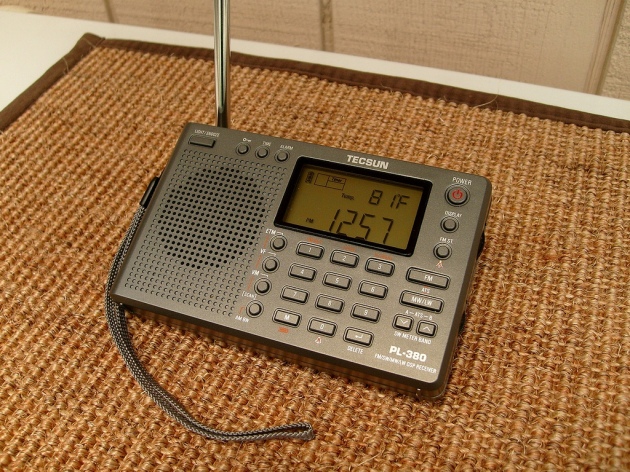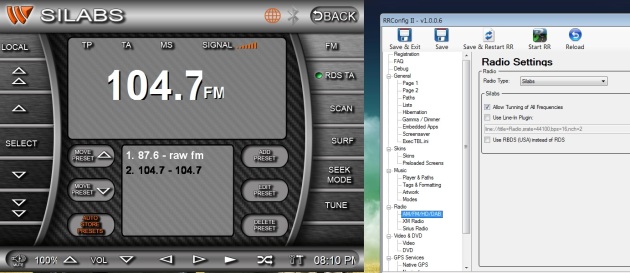FM USB Tuner Shootout: PC Ear vs Instant Radio (ADS Tech RDX-155)
January 25, 2014
Welcome to another radio shootout, Boxing Kangaroo edition! These shootouts feature ‘dirt cheap’ radios and are intended to appeal to a variety of different potential audiences, including terrestrial FM radio listeners and hobbyists interested in elementary electronics or FM reception capabilities.
Digital Signal Processing on the cheap?
At the time of writing, the cheapest Chinese portable FM radio currently available incorporating Silicon Labs’ (Silabs) Digital Signal Processing (DSP) costs about $49 including delivery. This model is the Tecsun PL-606. For those with a laptop and access to a directional antenna, USB computer devices with the SI4700/01 integrated circuit (IC) are considerably more inexpensive, representing a cheap entry to Silabs DSP.
The contenders: Two popular Silabs USB FM tuner
Instant FM Radio (Instant Radio) costs about $17 including delivery.
PC Ear costs about $17 wholesale but is no longer readily available new.
Gunning for the best: PC Ear versus Instant Radio
A rudimentary inspection of the datasheets suggest the FM sensitivity measurements are equivalent for the Silabs ICs inside PC Ear and Instant Radio. To test this, a modest directional antenna was connected to the devices. Both devices were housed in a metal enclosure with two suppression chokes and operated with a Radio Frequency (RF) quiet laptop running from battery power.
Reception conditions were well below average with heavy, unrelenting rain. 15 stations were chosen for the test. Of these, 13 stations were detected with the minimum signal strength of 0, where signals are just audible above the noise floor. Because of the heavy rain, two of the usual weak signals were not audible during the test and accordingly, do not appear in the performance table.
Software
PC Ear does NOT support firmware upgrades using the Windows-based Silabs configuration software utility. Firmware updates to PC Ear can be done under Ubuntu/Linux, but the process may be complicated. The Silabs Radio DLL software appears to function, but audio issues were evident when tested briefly with PC Ear. According to the developers, it is supported.
The upgraded firmware was used with Instant Radio. The upgrade was performed per the ADS Configuration user guide instructions for Silabs Radio DLL, developed by Beezer, Guino and Pete.
| Characteristic | PC EAR | INSTANT RADIO |
| Tunable frequency range | 76 – 90 MHz, 87.5 – 108 MHz | 76 – 90 MHz, 87.5 – 108 MHz |
| Circuit board approximate size | 1.3 x 0.6 inches | 2.4 x 1.1 inches |
| Tuning steps | 50 kHz | 50 kHz |
| Radio Data System support | No | Yes |
| Software support | USB Radio 2.0-3.0 (supplied), FM Signal Strength Analyzer 1.0.0.19, Silabs Radio DLL, Silabs configuration software utility. | Instant Radio 1.0.0.11 (supplied), Silabs Radio DLL, FM Signal Strength Analyzer 1.0.0.19, Silabs configuration software utility. |
| Hardware version | PC Ear 1.77 | Silabs 1.7.15 |
| Firmware upgradable | No, Please refer to body of article | Yes, ADS NoiseMod Primary.dec |
The software support listed in the characteristics table (above) is NOT exhaustive. Please understand that the priority was to test reception performance.
Any frequency (or broadcast) can be easily recorded for hours ‘on schedule’ using third party Windows audio recording schedule software such as Fox Magic Audio Recorder (free) and High Criteria Total Recorder Professional ($36). The software supplied with the devices also offers recording ‘on demand’. ADS Tech Instant Radio software is especially recommended for this purpose, since it offers high resolution 96 kHz uncompressed recording capabilities.
Comparative performance
PC Ear is constructed on a double sided printed circuit board, whilst the Instant Radio device uses a much larger single sided board (above). Unsurprisingly, both designs feature surface mount components.
| RADIO STATION FREQUENCY (MHz) | PC EAR MAXIMUM SIGNAL STRENGTH (BARS) | INSTANT RADIO MAXIMUM SIGNAL STRENGTH (NUMBER) | INSTANT RADIO RDS DECODING | DISTANCE (MILES) |
| 90.5 | 0 | 3 | No | 43mi (200 W) |
| 91.1 | 2 – Quieting Mono | 19 – Quieting Mono | Instant | 35mi |
| 92.1 | 0 | 6 | N/A | 43mi |
| 93.7 | 0 | 0 | N/A | 62mi |
| 94.9 | 0 | 6 | No | 27mi |
| 95.3 | 1 | 6 | N/A | 88mi |
| 98.5 | 1 – Quieting Mono | 9 – Quieting Mono | N/A | 88mi |
| 99.4 | 0 | 0 | No | 48mi (2 kW) |
| 99.5 | No signal, Slight high adjacent channel interference (99.7) | 0 | N/A | 208mi |
| 102.9 | 0 | 6 | N/A | 48mi |
| 104.5 | 4 – Quieting Stereo | 50 – Quieting Stereo | Instant | 11mi |
| 105.7 | 0 | 5 | No | 48mi |
| 107.7 | 5 – Quieting Stereo | 57 – Quieting Stereo | N/A | 11mi |
Instant Radio consistently offered a slight edge with superior adjacent channel suppression on one station and the advantage of RDS. PC Ear did ‘stutter’ occasionally on one RDS-enabled station. A change to the device settings (below) and immediately unplugging the device solved the problem. This trivial audio issue could not be replicated again after 15 minutes of listening to the station, nor the next day.
There were no consistently observable differences in sensitivity, audio quality or immunity to internally-generated spurious noise (interference) between the devices. This result was somewhat unexpected because PC Ear is rumoured to be an earlier Silabs USB tuner prototype with its share of critics on the world wide web. Perhaps the critics use the supplied wire antenna (in both devices, 29 inches long) and therein lies the problem? But the test suggests PC Ear performs just as well as Instant Radio with a directional antenna. If anything, the test was biased against PC Ear because of expectations the device was of poor design quality relative to its sister models.
Performance improvements
It should be stressed that Instant Radio and other Silabs devices require antenna modifications (below) for connection to a directional antenna such as a rooftop television antenna. Soldering skills are recommended for permanence. The use of other alternatives to ‘mate’ the device with an external antenna, such as passive induction as used in some mobile broadband device antennas might also be feasible, but discussion is beyond the scope of this shootout.
With the additional expense of a metal enclosure, shielded five metre USB cable, pre amplifier and several ferrite suppressors, the total cost equates to approximately $135. Many readers may already own much of this equipment, but it does represent a potential outlay. In this blogger’s opinion it is only worth pursuing such a project for the sheer fun of experimentation!
Notwithstanding the extra Do It Yourself (DIY) effort and cost required to extract the device’s DX potential, Silabs tuners feature satisfactory signal separation and strong signal handling. With the above modifications, Instant Radio is sensitive enough for daily signals from in excess of 265 miles. Momentary meteor pings from distant FM stations are possible to receive. Although untested at the time of writing, it is anticipated that modifications to PC Ear would accomplish the same. The bottom line is that these Silabs devices were designed for learning projects. It is NOT suggested to ‘throw good money after bad’.
Comparative performance with expensive stand alone tuners
As one should realistically expect because of the tiny footprint and price, the devices are outclassed by stand alone tuners with a proper shielded tuner module. Even with a preamplifier used in-line to desperately boost sensitivity, this is apparent. Head-to-head, the following tuners or SDRs (tested without preamplifiers, using the same antenna) all noticeably outperform Instant Radio (FM usable sensitivity* is listed in brackets):
- Blaupunkt Casablanca CD51 (1.68 microvolts),
- Elad FDM-S2,
- Sherwood TX-5090 RDS (1.58 microvolts),
- Yamaha TX-950 (0.8 microvolts).
For example, in a ‘dead-of-winter’ test, the Blaupunkt automotive receiver consistently achieved better performance than Instant Radio. Improved RDS sensitivity meant that the car radio decoded digital RDS data from two extra stations. Like all models in the Sharx range, the car radio more readily discriminated stations spaced 100 kHz apart.
Instant Radio was capable of receiving 2/3 of the 15 weak signals chosen for the test, whilst the car radio nabbed 93% of weak signals! The Silabs devices enable reception of the same stations from in excess of 265 miles as standalone tuners. However, this reception will obviously be more transient and weaker signals are unlikely to be audible. From a DX enthusiast’s perspective, that may be a frustrating prospect.
The number of RDS decodes achieved with Instant Radio was equivalent to the Bauhn ADS-215 dual band portable radio connected to a carefully aligned rabbit ears antenna mounted near a window. Invariably, Instant Radio outperformed the Bauhn portable radio using its inbuilt telescopic antenna.
Summary
The device incorporating the Silicon Labs’ SI4701 IC (marketed as ‘Instant Radio’, above) is one breed of flash-drive sized computer tuner that offers modest potential for weak FM signals. It suits receiving locations with a congested FM band. Its full RDS capabilities can be exploited in locations where broadcasters support the system. PC Ear also offers similar performance, without RDS decoding.
All software tested works successfully on both receivers without noticeable bugs. There is a range of tuning software to choose from. Both Silabs devices are suited to DIY modifications. Users of Instant Radio benefit from access to the latest firmware.
Further reading
Instant Radio for distant FM reception
Instant Radio satirical shootout
Radio recording saved the radio star
* Standard DIN sensitivity specifications, tested with THD 3% & S/N of 26 dB. Official data, sourced from manufacturers. Lower numbers (approaching zero) indicate the best FM sensitivity. The Elad FDM-S2 sensitivity is measured differently from conventional tuners. This SDR offers better than 2 microvolts using the 12dB SINAD measurement on the extended FM band.
As always, the writer has no affiliation with any retail merchant or product manufacturer. This entry is NOT intended to be construed as an endorsement of any particular model. Prospective buyers should carefully make their own enquiries according to their particular needs and circumstances.












